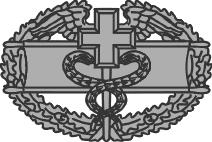
It was originally created in 1945 as a way to recognize the Medics that had served alongside the Infantry in WWII. Originally there was a $10 a month pay bonus added to it. Later the award was amended to allow for multiple awards, not for multiple deployments, but for seprate wars. To date there have been only TWO known recipeints of three CMB awards (denoted by two stars one on top one on botom)
According th AR 600-8-22 a person must be assigned to an infantry regiment (brigade) or smaller, be COL or below, and not only be engaged by hostile forces but must also treat the wounded WHILE under hostile fire. Neither the CIB (Combat Infantry Badge) or the newer CAB (Combat Action Badge) are that restrictive. In fact many medics that were under hostile fire but did not treat anyone were not given ANY award, and some like my Lab Tech friend, Katie, are not eligable at all.
Thus far in the Global War On Terrorism (GWOT for short) there have been over 26,000 CIBs awarded, and 27,000 CABs. While these sound like a lot, when you take into acount that the CAB was not created until 2005, and the award was retro-active, there are a lot more that are probably eligable that either don't care, don't want it, can't get their unit to give it, or are out of the Army.
no compare that to just over 9,000 CMBs awarded. Almost a third of each one of the awards and put together far less, yet it is these individuals that have kept such a high save percentage. Over 95% of those injured in Iraq or Afghanistan survive. Sometimes the injuries survived are so traumatic that miracilous is the only word that can be used to describe it.
I feel that while it is important to recognize medics doctors, PAs, and Nurses with this badge, I think it is far too often overlooked. I have bristled when asked "what's up with the weird jump wings" and often when passing by the PX or other places I see almost NO pride type novelty items for medics. Oh there's many for the infantry, hell whole sections almost, and even for the many MOS' that get the CAB, but the CMB seems almost like the forgotten cousin. I have shared the same risks as the infantry, and sometimes it feels as if the army is trying to elbow out the Medic with the CLS (Combat Life Saver) course.
What bothers me most about CLS, is when I get non-medical types second guessing me, or worse getting in my way when I have a job to do. While it is nice to have the extra hands durring a MasCal, it is also infuriating when i get second guessed by people.
It took me a long time to accept that my role will forever bee seen as "support" eventhough I was out there as much as the LT or PSG (in fact it is usually standing policy that as a medic I HAVE to go on EVERY mission, which has often made my life difficult). because i was "valuable" I was often "protected" or held back. If I kicked in a door or tried to "stack up" I was often barrated for placing myself in unnessisary risk. I don't know which is more frusterating being told I had to be protected or realizing that my input would only be accepted within the scope of my speciality, and in the end often ignored when making descisions.
I chose my profession, and I love my job. I love being a Line Medic, and I love being "Doc" but, unfortunatly at every turn I am reminded that I am NOT infantry. My heart may be True Blue, but I will always be apart. While this distinction can often fill me with pride, it also can make me feel isolated.
No comments:
Post a Comment